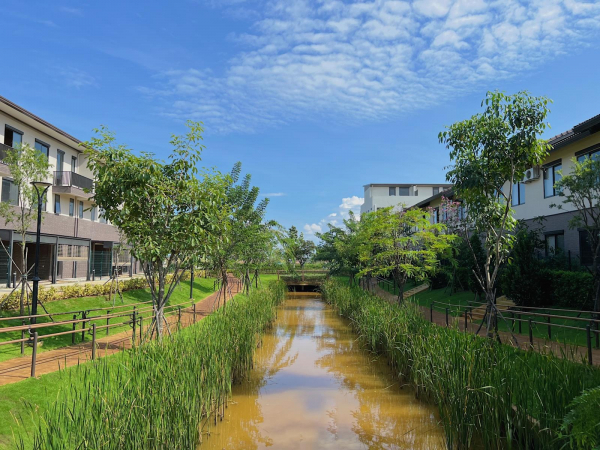[vc_row][vc_column][vc_column_text]In the competition to attract genuine buyers, large urban areas are on the verge of winning as customers lean towards homeownership in these areas, especially after Covid-19 pandemic.
Genuine buyers prefer properties in urban areas
Urban areas at the size of hundreds of hectares, with full facilities integrated have been the first choice of genuine buyers, especially when living space becomes a greater interest post Covid-19.
According to Batdongsan.com.vn’s market research, the majority of townhouses and apartments in high demand are located in large urban areas across Ho Chi Minh City, Long An, Dong Nai, etc. For example, Mizuki Park township (Binh Chanh), has a size of 26 ha and more than 2,000 residents. The current occupancy rate for phase 1’s completed subdivisions is 98%. Other subdivisions are highly welcomed in the market and are being sold at increasing prices of 20 to 25%. In early October, the 2 blocks MP9-MP10 with 166 apartments opened for sale at VND 2.5 billion/unit, also attracted buyers’ interest.

Besides villas and townhouses, the apartments in these urban areas also attract genuine buyers even though the selling prices are not low. Illustration
In the East, at the 198-ha Van Phuc City developed by Van Phuc 10 years ago, the occupancy rate in the completed subdivisions reaches 60 to 70%. Although the transfer price has gone up by 50 to 60%, it still receives buyers’ attention. The project is currently offering townhouses, villas, and later, apartments at high prices yet high liquidity. Despite there is still little information about the launch, apartments in this urban area have been considered a good investment on the market.
Similarly, at another urban area i.e. Vinhomes Grand Park in Ho Chi Minh City, Thu Duc (previously district 9), The Beverly subdivision consisting of 10 luxury apartment buildings opened for sale at an expected average price of VND 68 million/m2 but the demand has remained high. Since opening for sale in 2019, this mega township has supplied thousands of apartments to the market which were all quickly sold out.
Not only in Ho Chi Minh City, urban projects that meet the requirements for facility, security and resident’s education level in surrounding suburbs also attract buyers, such as the 355-ha Waterpoint (Long An) developed by Nam Long Group. At the end of 2020, the investor officially handed over 600 townhouses and villas in the Rivera 1 and Aquaria 1 to customers. At the moment, the majority of these properties have been occupied by residents. In Q4/2021, the investor will continue to hand over the Aquaria 2 subdivision and is expected to attract more residents.
Or a series of ongoing projects in Dong Nai, Binh Duong, namely Aqua City Bien Hoa (1,000ha), Long Hung City (277ha), Son Tien (380ha), Swan Bay (200ha), Angel Island ( 205ha), etc.
The vitality of a project has become more important
The added value when buying real estate in the urban area is not met by all projects. This is the main factor that makes even though the pandemic is complicated, urban residential projects are still chosen by real buyers to settle down, even though the house prices in these projects are often higher than the selling prices of many retail projects. . To create vitality for the project requires investors to have vision, capacity, project development experience and importantly, enough resources to be able to implement projects according to the given plan in a timely manner. feasible and fulfill commitments with customers.

In addition to facility and infrastructure, high occupancy rate is also a contributing factor to attracting buyers in urban areas.
According to Nguyen Huong, General Director of Dai Phuc Land, the vitality of a project is reflected in the pace, including construction speed, operation pace, and above all, the human factor. An urban area with high occupancy rate, crowded streets, and bustling vibe is highly vital. Usually, a project site needs to be filled by 50% within 3-5 years to have good vitality. The faster the occupancy rate, the better the vitality and the higher the added value.
Discussing the factors contributing to project vitality, Huong said that the reputation and brand value of the project developer are prerequisite elements. This ensures the feasibility of the project. A project even with a beautiful and shimmering plan, will not attract buyers if the construction site is quiet. The development of a project must be accompanied by a sales plan, a clear and specific construction plan and a commitment to delivery schedule.
Furthermore urban planning must ensure a full and synchronous ecosystem for the residents. Many projects are beautifully designed but developed in fragments, to include traffic infrastructure but ignore facilities. As a result, residents find it difficult to live because their basic needs are not satisfied. The project location must be closed to neighboring residential areas according to the principle of oil spill. A project will hardly have any vitality if it is “a market alone”. Traffic must be conveniently connected for work, study and entertainment. There are only a few projects that do this well. Vitality will be a decisive factor in the success of a project. As the living quality is improved, the real estate value increases, giving homebuyers and investors the returned benefits.
Source: batdongsan.com.vn
[/vc_column_text][/vc_column][/vc_row]